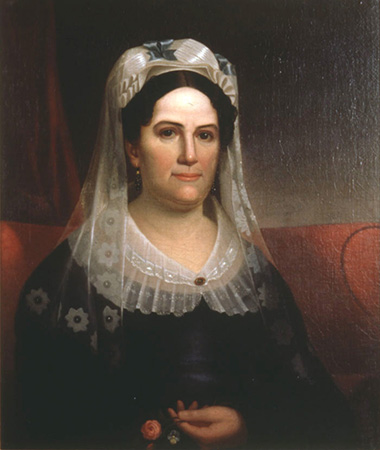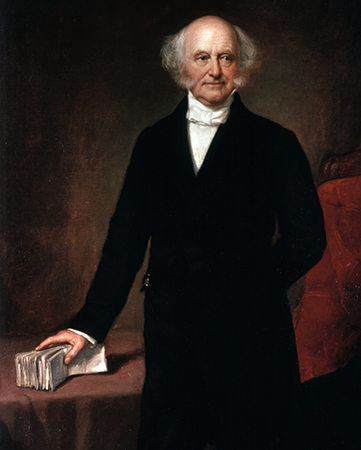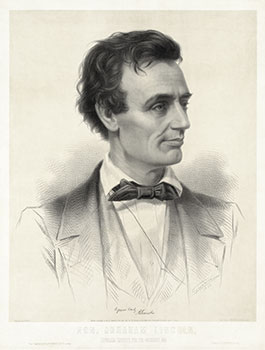Learn
Jacksonian Democracy
Jackson's Reputation and Election
Perhaps one of the most controversial men to serve as the President of the United States was Andrew Jackson. Although Jackson had a solid reputation as a war hero and was regarded as a "man of the people", many of his policies impacted the United States for decades after his presidency.
Jackson was an admirer of Thomas Jefferson and his Jeffersonian Democracy. However, Jefferson said of Jackson, "I feel much alarmed at the prospect of seeing General Jackson President. He is one of the most unfit people I know of for such a place....His passions are terrible....He is a dangerous man."

Self-Made Man
Jefferson may have been so critical of Jackson because Jackson was everything his predecessors were not. Unlike most of the Founding Fathers:
- He was not from a prominent colonial family. In fact, Jackson was born in a log cabin two years after his parents settled in Kentucky.
- He was a self-made man.
- He was not well-educated.
Jackson was the opposite of the New England and Virginian intellectuals who had spearheaded the American Revolution and written the United States Constitution.
Military Service
Jackson was also a self-made military man, and he had no formal military training. He was our only president to serve in both the Revolutionary War and the War of 1812.
Jackson was also our only president to be held as a prisoner-of-war. At age 13, he served in the Revolutionary War and was captured by the British. While in custody, he refused to clean the boots of a British officer, who struck his face with a saber. The blow scarred his face.

As you learned previously, Jackson became famous during the War of 1812, first in the Creek War in Alabama and then at the Battle of New Orleans
Contradictions
In addition, Jackson was a man of contradictions.
- He fought against Native Americans, but adopted a Native American infant found after a battle.
- Native Americans fought by his side during the Creek War and the Battle of New Orleans in 1815, yet he supported the Indian Removal Act in 1830.
- He was a champion of the "common man", but he bought and sold slaves for his plantations.
1824 Election
Andrew Jackson first ran for President in 1824 and won the popular vote, but he failed to secure enough electoral votes. When the election was decided by the House of Representatives, Jackson was defeated by John Quincy Adams, son of former President John Adams.
Not only was Jackson furious at the defeat, but his followers (called Jacksonians) believed that Adams had stolen the presidency and Jackson had been given a corrupt bargain. They left the Democratic-Republican Party, which split into two factions: the National Republicans and the Democrats. Later, this organization would become the Democratic Party.
Voting Rights Changes and the 1828 Election
While the 1824 election didn't go his way, Jackson did secure the presidential spot in the 1828 election. His victory was due to changes in political parties and the expansion in voting rights.
During John Quincy Adams's administration, voting numbers increased as many states relaxed voting requirements. Many states adopted universal manhood suffrage, meaning all white males could vote; previously, only male landowners were allowed to vote. In the election of 1824, approximately 350,000 white males voted. By 1828, over three times that number voted, and they overwhelmingly voted for Andrew Jackson. (By 1856, all states had adopted universal manhood suffrage!)
In addition, electors (who are part of the Electoral College and cast votes for the president) were now elected by popular vote rather than by state legislatures. This change also helped secure a victory for Jackson in 1828.

Jackson was not responsible for these changes, but he supported and benefited from them.
Rachel Jackson
The election of 1828 between John Quincy Adams and Andrew Jackson was a mudslinging contest, with insults and accusations (especially unjust ones) thrown back and forth in hopes of damaging the other's reputation.
In 1794, a few years after Jackson married Rachel Donelson, they discovered that she had not actually divorced her first husband! After the state legislature granted Rachel a proper divorce, she and Jackson remarried. Her history was used against Jackson more than 30 years later in the election of 1828. Jackson even killed a man who insulted her in a duel. Rachel died two months before Jackson's inauguration, and he blamed his opponents and their attacks for her death.

Expanding the Presidency
In 1860, biographer James Parton concluded that Andrew Jackson was "a most law-defying, law obeying citizen."
Jackson expanded the role of the president and for that he was frequently pictured as a wanna-be king as seen in this political cartoon.

Jackson's broad interpretation of the Constitution dates even before his presidency.
- In 1814, he declared martial law in New Orleans, which suspended all civil law and was completely illegal.
- In 1817-1818, during the Seminole Wars, Jackson illegally invaded Spanish territory and captured Pensacola.
So why was Jackson allowed to ignore the Constitution? He won. It's that simple! No one had an inclination to take the war hero to task about his methods.
Jackson believed he had a mandate from the people to act in what he saw as their best interest. As a result, he vetoed more bills than any of his predecessors. Because the Constitution makes a Congressional override to a veto very difficult, the use of the veto demonstrated his power over the legislature.
Jackson refused to act on Worcester v. Georgia, which favored the Cherokee nation. Hence, he used the office of president to defy the Supreme Court.
Jacksonian Democracy
Jacksonian Democracy was the political movement toward greater democracy for the common man, typified by Andrew Jackson, and it encompassed two presidents: Jackson and Martin Van Buren.

We're going to talk about the five aspects of Jacksonian Democracy:
- Extension of voting rights: Voting rights expanded as long as you were white and male. (Change takes time!)
- Common Man Ideal : Jackson was the common man and voters identified with him.
- The Spoils System: This meant jobs in government were given to those who helped you get elected
- Nullification Crisis: The United States came this close to Civil War.
- Indian Removal Act of 1830: This would definitely come under the heading of "evil".
Voting Rights
Voter qualification was left to the states by the Constitution. Consequently, the rules were differed from state to state.
A giant step forward took place in 1830 when voting rights were extended to all white men in many states. By the 1856 election, nearly all white men could vote for president. Read The Expansion of the Vote: A White Man's Democracy to learn more about this change.
Suffrage, or the right to vote, would be a long struggle for African Americans, women, and Native Americans. It would take both constitutional amendments and acts of Congress to create truly universal suffrage that included all US citizens regardless of race, ethnicity, or gender.
Common Man Ideal
The common man ideal was not a new thought to Jacksonian Democracy. American and French writers alike had promoted the idea that ordinary men could self-rule. The American Revolution was a giant step in that direction! Through the first years of the republic, the ordinary man became more enfranchised.

So, what is a common man? He was an ordinary man! He could be a farmer, trader, frontiersman, soldier, craftsman, store owner, clerk, etc. In short, this is any normal person.

So, what is the common man ideal? It is the concept that ordinary men can rule themselves and accomplish great things.
Andrew Jackson used the common man ideal to further his political career. He claimed to be a common man because he came from humble beginnings and achieved fame and prospered. How he implemented this concept of the common man leads us to the next topic – the spoils system.
The Spoils System
As president, Jackson wanted to purge the government of corruption and laziness. He said that many officials had just been in office too long; in fact, many had been in office since George Washington's administration. Consequently, he fired many government officials under what he called rotation in office. He replaced these corrupt, long-standing officials with his supporters, believing that these common men would restore virtue and morality to the government.
Jackson defended his right to remove people from government positions in his first message to Congress, saying, "In a country where offices are created solely for the benefit of the people, no one man has any more intrinsic right to official station than another."
Since he used his supporters as replacements for the removed officials, the practice was called the spoils system by his enemies and the name stuck.
This political cartoon shows how his enemies felt about the practice!

Jackson's worst appointee was an old Army buddy of his named Samuel Swartwout, who he appointed as collector of the New York City Customhouse. The collector was a federal officer in charge of collecting import duties taxes on foreign goods that entered the United States by ship at the Port of New York. The city customhouse is where the federal government collected nearly half of its annual revenue! While in this position, Swartwout stole more than one million dollars!
Despite men like Swartwout, the custom of appointing friends to high-paying positions in the government has continued to the 21st century.
The immediate result of the new rotation in office or spoils system was mixed. Some appointees were competent government employees. Other appointees were not so competent and were sometimes as corrupt as their predecessors. This turned out to be not much different than the old system. Yet, the spoils system became the standard for appointed government positions.
Nullification Crisis
The nullification crisis is an important event during Jackson's administration that dealt with states' rights versus the federal government. The crisis almost led to secession and civil war. In fact, South Carolina threatened secession in the 1830s due to the nullification crisis, and it was first state to secede in 1860 when civil war actually did break out.
The South Carolina legislature passed a Ordinance of Nullification in 1832 in response to new tariffs, or taxes, the federal government had enacted on imported goods in 1828 and 1832. In this act, South Carolina stated they would "nullify" the tariffs -- or consider them "null and void" -- and not pay them.
These so-called Tariffs of Abomination exacerbated the growing tensions between the North and the South. The tariffs were high duties on imported goods that protected American manufacturers by keeping the cost of domestic goods lower. The South was a big importer of goods, while the North was not -- remember the North was more industrialized and they had their own factories!
Just prior the tariff is being enacted, southern states had experienced a dramatic economic downturn throughout the 1820s. South Carolina is one of the worst hit states after the economic Panic of 1819. This dire financial situation lasts until 1829. They were concerned these protective tariffs might further hurt their struggling economy.
Also, South Carolina saw the tariffs as an expansion of federal authority and the "protection" of domestic goods as a sectional policy that unfairly benefited the industrial North over the agrarian South. They threatened to secede from (or leave) the union based on the argument of states' rights or the belief that they had the right as a state to override federal rule in the domain of their state.
Remember John C. Calhoun? He was the South Carolinian politician who drew up the argument for nullification and concurrent majority. His theory of concurrent majority was an argument for how to protect voting minorities (the states) from the 'tyranny' of the majority (the United States federal government).
However, as the February 1, 1833 deadline approached when South Carolina said it would refuse to pay the duties, everyone realized how great the damage would be if South Carolina did secede and violence broke out.
Remember Henry Clay? The Kentucky senator authored a compromise where the tariffs would be gradually reduced over the next decade. Both sides agreed to it, which stopped the crisis before secession and war occurred.


The nullification crisis was a clear example of the sectionalism that was growing increasingly more volatile in the United States as the 19th century progressed.
Indian Removal Act of 1830
In 1803, President Jefferson said to a Choctaw delegation,
"It is hereby announced and declared, by the authority of the United States, that all lands belonging to you, lying within the territory of the United States shall be and remain the property of your Nation forever, unless you shall voluntarily relinquish or dispose of the same."
As we know, this would not remain the intent of the United States.
As we have studied previously, the story of the Native Americans and the United States government is a saga of broken promises, broken treaties, and underhanded manipulations.
The majority of Native Americans wanted to continue in their old ways of living off the land by hunting, gathering, and farming.
Although Andrew Jackson once sided with Native Americans, he ignored the Supreme Court ruling in Worcester v. Georgia and forced Native Americans off their tribal lands with the Indian Removal Act of 1830. Jackson continued the government's legacy of disregard for Native American peoples. We will learn more about the Indian Removal Act later in this unit.
Van Buren
Martin Van Buren followed Jackson as president and continued the hallmarks of Jacksonian Democracy. Watch the video Martin Van Buren | 60-Second Presidents (1:24) for an overview of Van Buren's presidency.
Open Martin Van Buren | 60-Second Presidents in a new tab
Then, read Jacksonian Democracy and Modern America to see how Martin Van Buren furthered the Democratic Party and the democratization of America, as well as how the Whig Party split from the National Republicans and other opponents of Jackson. This period from 1828 to 1854 is known as the Second Party System.
Read Whig Party, if you'd like to learn more about them.